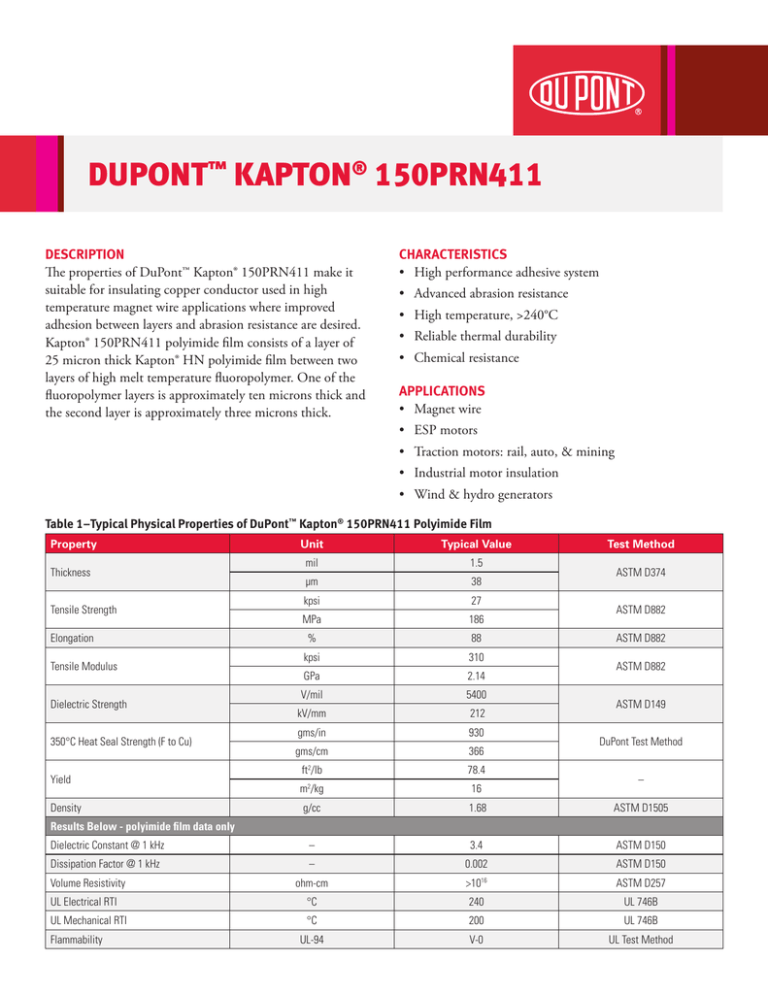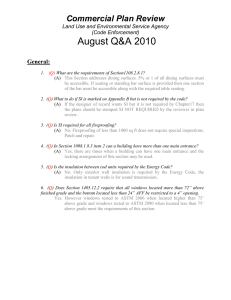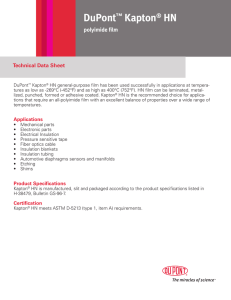
DUPONT™ KAPTON® 150PRN411
DESCRIPTION
The properties of DuPont™ Kapton® 150PRN411 make it
suitable for insulating copper conductor used in high
temperature magnet wire applications where improved
adhesion between layers and abrasion resistance are desired.
Kapton® 150PRN411 polyimide film consists of a layer of
25 micron thick Kapton® HN polyimide film between two
layers of high melt temperature fluoropolymer. One of the
fluoropolymer layers is approximately ten microns thick and
the second layer is approximately three microns thick.
CHARACTERISTICS
• High performance adhesive system
• Advanced abrasion resistance
• High temperature, >240°C
• Reliable thermal durability
• Chemical resistance
APPLICATIONS
• Magnet wire
• ESP motors
• Traction motors: rail, auto, & mining
• Industrial motor insulation
• Wind & hydro generators
Table 1–Typical Physical Properties of DuPont™ Kapton® 150PRN411 Polyimide Film
Property
Thickness
Tensile Strength
Elongation
Tensile Modulus
Dielectric Strength
350°C Heat Seal Strength (F to Cu)
Yield
Density
Unit
Typical Value
mil
1.5
µm
38
kpsi
27
MPa
186
Test Method
ASTM D374
ASTM D882
%
88
kpsi
310
GPa
2.14
V/mil
5400
kV/mm
212
gms/in
930
gms/cm
366
ft2/lb
78.4
m /kg
16
g/cc
1.68
ASTM D1505
–
3.4
ASTM D150
2
ASTM D882
ASTM D882
ASTM D149
DuPont Test Method
–
Results Below - polyimide film data only
Dielectric Constant @ 1 kHz
Dissipation Factor @ 1 kHz
–
0.002
ASTM D150
ohm-cm
>1016
ASTM D257
UL Electrical RTI
°C
240
UL 746B
UL Mechanical RTI
°C
200
UL 746B
UL-94
V-0
UL Test Method
Volume Resistivity
Flammability
DUPONT™ KAPTON® 150PRN411
PROCESSING SUGGESTIONS:
Recommended Overlap
Laboratory test results indicate that improved mechanical
performance can be achieved by using either “positive” or
“negative” overlaps. The overlap that is used should be
consistent with the dielectric properties that are needed for
the insulation.
have enhanced mechanical abrasion resistance. The two
fluoropolymer layers have been tinted with a small amount
of pigment so that they can be easily differentiated. The
abrasion resistant layer has been tinted to have a tan color
and the high adhesion layer has been tinted red. It is
recommended that red side of the tape be oriented toward
the copper for most magnet wire applications.
The modulus of elasticity (i.e. stiffness) of the polyimide film
used to produce the PRN product is the same as the modulus
of the polyimide film used to produce the Kapton® FN
products. The surface characteristics of the PRN material are
different than the surface properties of the FN products.
These surface differences will result in less friction between
the insulation tape and the taping machine components. This
difference in friction properties may require taping machine
adjustments be made to properly apply the tape to the
conductor (ex. clutch adjustments, etc.).
Both the abrasion resistant layer and the adhesive layer have
been made using fluoropolymer that are more thermally
stable and have higher melt points than the FEP used in the
Kapton® FN and FWN products. As a result the process
temperature that is required to fuse the tape layers to each
other and to fuse the tape to the conductor will be higher
than the temperature needed to fuse the FN and FWN
materials. Laboratory tests indicate that in order to achieve
good adhesion between the insulation and the conductor,
the conductor and the insulation temperature must be at
least 315 degrees Celsius.
Fusing the Tape to the Conductor
Handling Wire Insulated with 150PRN411
The PRN material is an unbalanced composite structure
with a Kapton® polyimide core that is covered with
fluoropolymer on both sides. The type of fluoropolymer that
is used in each of the layers is tailored to yield the best wire
insulation properties. The fluoropolymer on one side of the
film is designed to have good fusing properties while the
fluoropolymer on the opposite side of the film is designed to
The outer surfaces of 150PRN411 become soft when they
are heated near their melt point. While they are at this
elevated temperature the outer fluoropolymer surface can be
easily marred by coming in contact with foreign objects. The
use of nip rolls on the wire during the manufacturing
process, while near the fusing temperature of the
fluoropolymer, is not recommended.
Applying Material to the Conductor
kapton.com
This information corresponds to our current knowledge on the subject. It is offered solely to provide possible suggestions for your own experimentations. It is not intended, however, to substitute for
any testing you may need to conduct to determine for yourself the suitability of our products for your particular purposes. This information may be subject to revision as new knowledge and
experience becomes available. Since we cannot anticipate all variations in end-use conditions, DuPont makes no warranties, and assumes no liability in connection with any use of this information.
Nothing in this publication is to be considered as a license to operate under or a recommendation to infringe any patent right.
CAUTION: Do not use in medical applications involving permanent implantation in the human body. For other medical applications, see “DuPont Medical Caution Statement,” H-50102-5.
Copyright © 2014 DuPont. All rights reserved. The DuPont Oval Logo, DuPont™, and all DuPont products denoted with ® or ™ are registered trademarks or trademarks of E. I. du Pont de Nemours
and Company or its affiliates. K-28731 12/14




